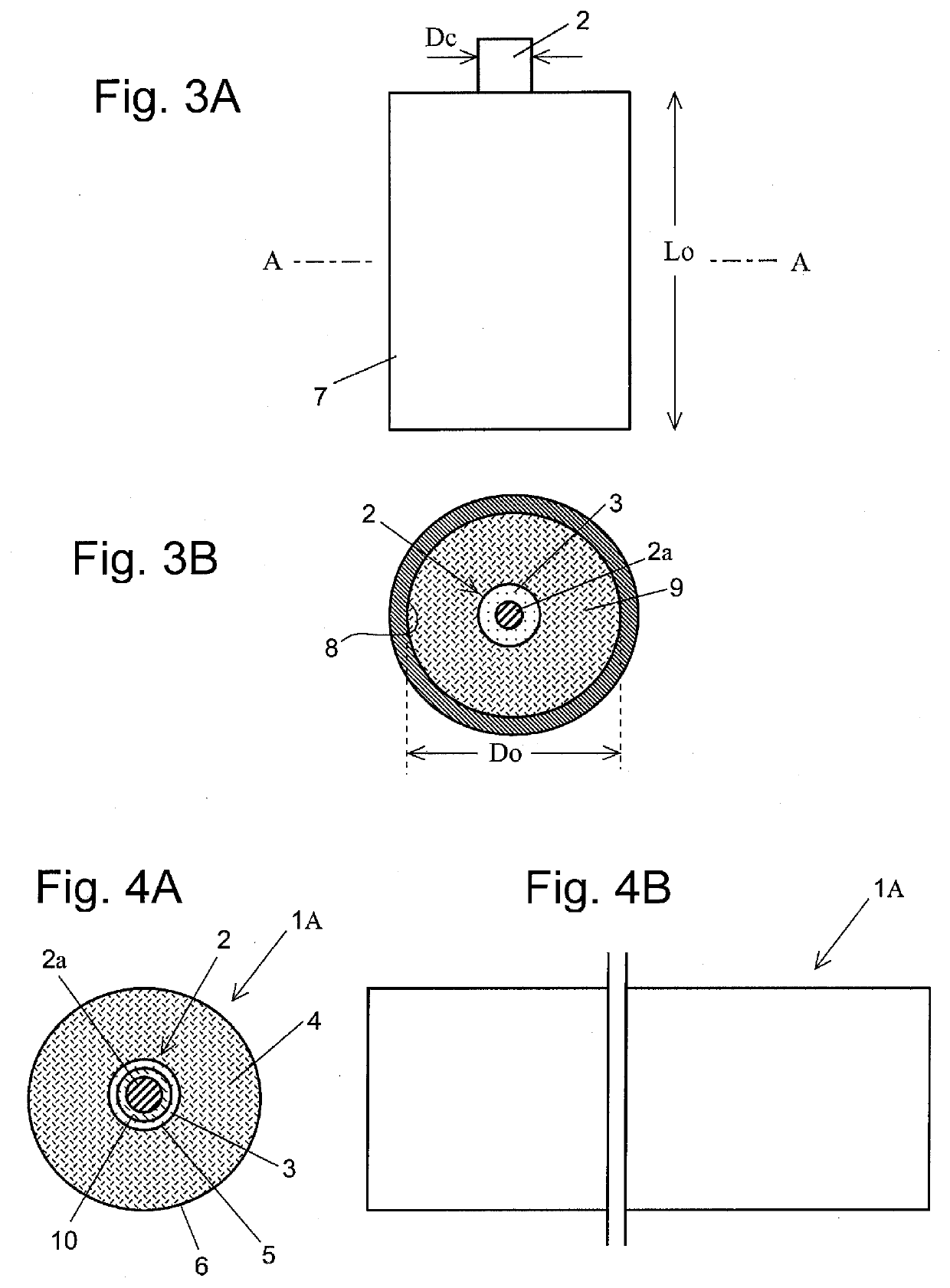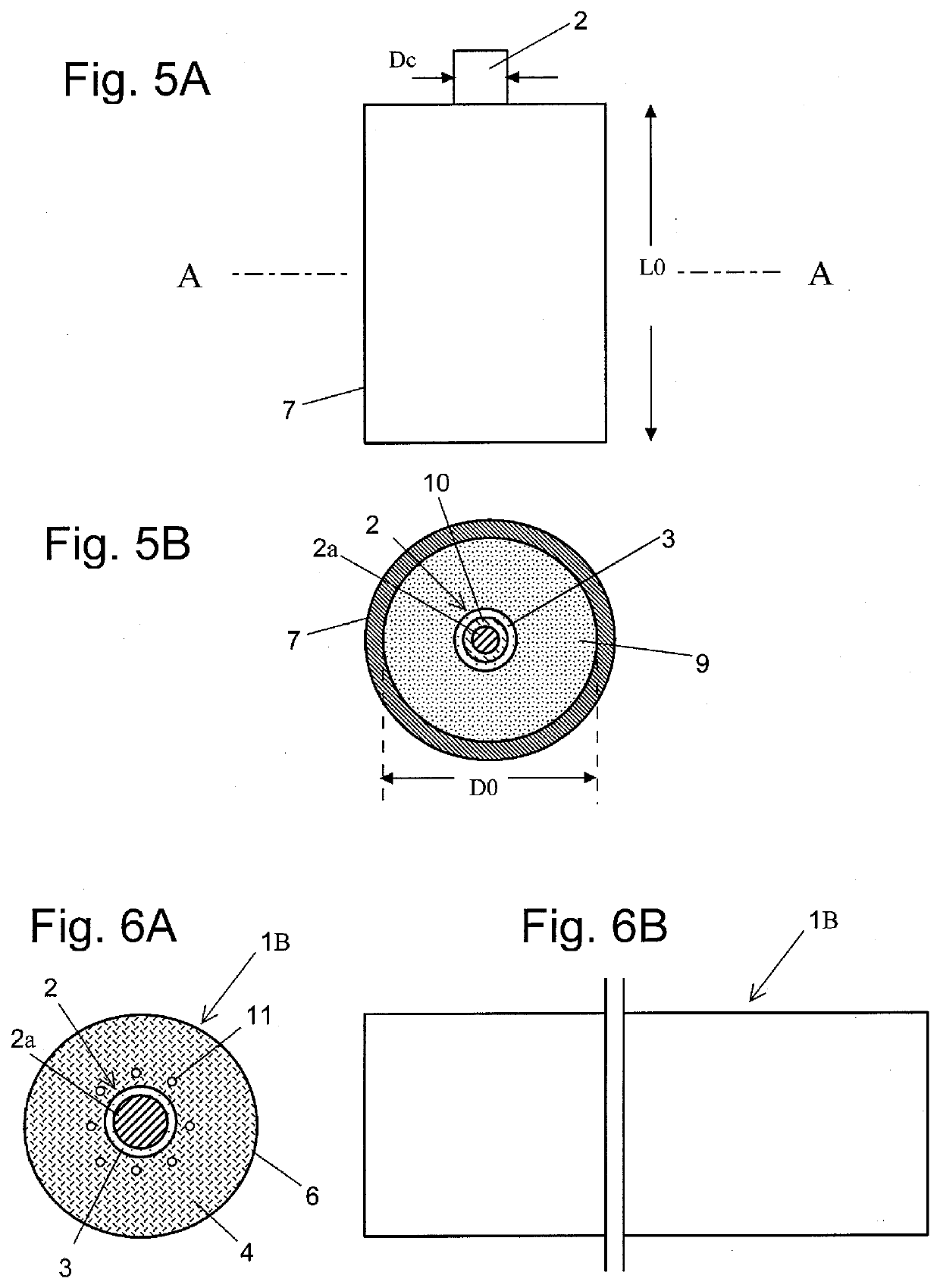Method for Manufacturing Optical Fiber Base Material and Optical Fiber Base Material
a manufacturing method and technology of optical fiber, applied in the field of base materials, can solve the problems of troublesome and costly processing steps, and achieve the effects of long optical fiber, low scattering loss, and high dimensional precision
- Summary
- Abstract
- Description
- Claims
- Application Information
AI Technical Summary
Benefits of technology
Problems solved by technology
Method used
Image
Examples
first embodiment
[0114]FIGS. 1A and 1B illustrate a first embodiment of an optical fiber base material of the present invention.
[0115]FIG. 1A is a front cross sectional view of the optical fiber base material, and FIG. 1B is a side view of the optical fiber base material. An optical fiber base material 1 of FIGS. 1A and 1B includes: a SiO2 glass rod 2 containing SiO2 glass for a core (hereinafter, referred to as glass rod 2); and a SiO2 cladding layer 4 that covers the outer periphery of the glass rod 2. The center of the glass rod 2 is made of a SiO2 glass layer 2a to which GeO2 is added within a range of 5 weight % to 25 weight %, and the outer periphery of the glass rod 2 is made of a SiO2 glass layer 3. The glass rod 2 is formed according to a method of the present invention.
[0116]The SiO2 cladding layer 4 is obtained by: pouring a quartz glass solution containing a hardening resin, and a hardener into a metal container; solidifying the quartz glass solution and the hardener through a self-harde...
second embodiment
[0130]FIGS. 4A and 4B illustrate a second embodiment of the optical fiber base material of the present invention. FIG. 4A is a front cross sectional view of the optical fiber base material, and FIG. 4B is a side view of the optical fiber base material.
[0131]An optical fiber base material 1A of FIGS. 4A and 4B is an embodiment of a large-diameter optical fiber base material. The optical fiber base material 1A is manufactured using a metal container illustrated in FIGS. 5A and 5B. The glass rod 2 of the optical fiber base material 1A includes: the SiO2 layer 2a to which a GeO2 additive for enhancing a refractive index is added, in the center of the glass rod 2; a SiO2 layer 10 to which F is added, in the outer periphery of the SiO2 layer 2a; and the SiO2 glass layer 3 to which F is not added, in the outer periphery of the SiO2 layer 10. The SiO2 cladding layer 4 is formed in the outer periphery of the glass rod 2, using the metal container 7 illustrated in FIGS. 5A and 5B.
[0132]The me...
third embodiment
[0133]FIGS. 6A and 6B illustrate an embodiment of a hole assisted optical fiber base material of the present invention. FIG. 6A is a front cross sectional view of the optical fiber base material, and FIG. 6B is a side view of the optical fiber base material. An optical fiber base material 1B of FIGS. 6A and 6B is manufactured using: the first base material (glass rod 2) described in the first embodiment; the metal container 7 (see FIGS. 3A and 3B); and a plurality of stainless-steel metal rods (not illustrated) (each having a surface roughness of 0.03 μm or less). First, the first base material is arranged in the center of the metal container 7, and the plurality of stainless-steel metal rods are arranged at preset intervals in the outer periphery of the first base material. In this state, the mixed solution 9 of: the quartz glass solution containing the hardening resin; and the hardener is poured into the metal container 7. The mixed solution 9 is solidified through a self-hardenin...
PUM
| Property | Measurement | Unit |
|---|---|---|
| surface roughness | aaaaa | aaaaa |
| surface roughness | aaaaa | aaaaa |
| surface roughness | aaaaa | aaaaa |
Abstract
Description
Claims
Application Information
 Login to View More
Login to View More - R&D
- Intellectual Property
- Life Sciences
- Materials
- Tech Scout
- Unparalleled Data Quality
- Higher Quality Content
- 60% Fewer Hallucinations
Browse by: Latest US Patents, China's latest patents, Technical Efficacy Thesaurus, Application Domain, Technology Topic, Popular Technical Reports.
© 2025 PatSnap. All rights reserved.Legal|Privacy policy|Modern Slavery Act Transparency Statement|Sitemap|About US| Contact US: help@patsnap.com



